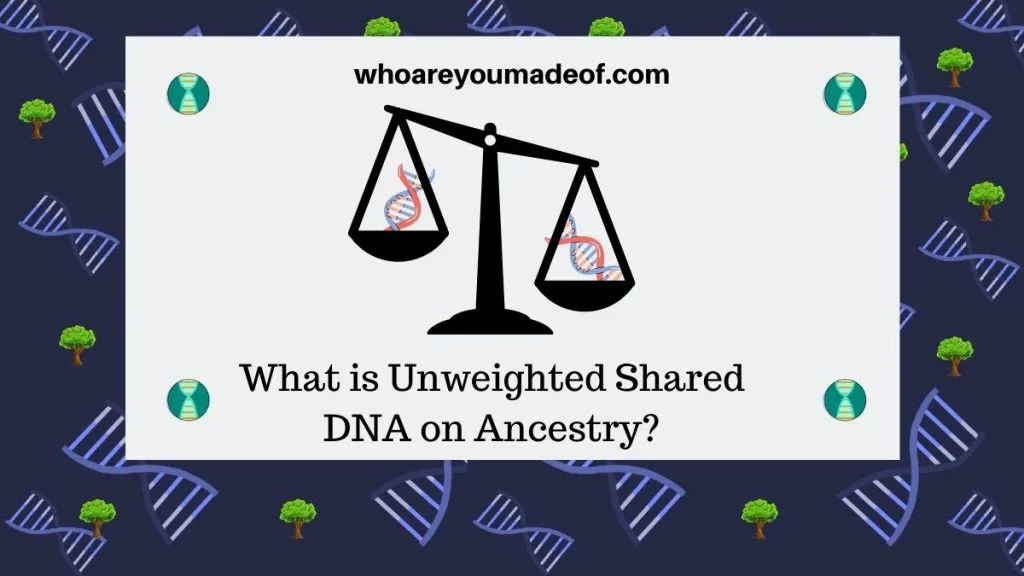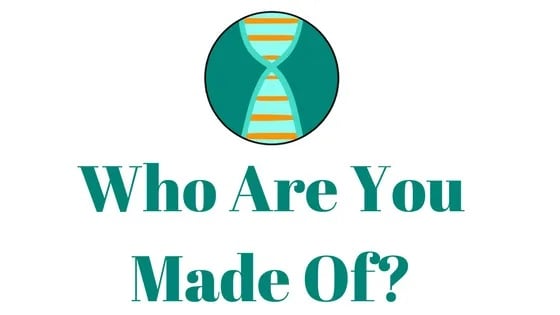Do you want to learn about the unweighted shared DNA data on Ancestry? In this post, find out the differences between weighted and unweighted shared DNA, how this information is calculated and how to use it in researching your connection to your DNA matches.
You will learn:
- Where to find unweighted shared DNA on your DNA match list
- Exactly what is unweighted shared DNA
- What’s the difference between weighted and unweighted DNA
- How to understand the weighted shared DNA details

The unweighted shared DNA feature was added to Ancestry in 2020. Prior to this change, we could only see the total amount of shared DNA along with the total number of shared DNA segments.
It is very helpful to have access to the total amount of shared DNA, the size of the longest segment, and the total amount of unweighted shared DNA. However, we often have more questions as we get access to more information.
I hope that the information that you find in this article helps you understand this information and learn more from your match list.
Where to find unweighted shared DNA details on Ancestry
To find the unweighted shared DNA, you must first choose a DNA match to examine. Then, click on the blue link containing the total shared DNA and number of DNA segments that shows up after “Shared DNA”.
The image below indicates exactly where you should click to access the unweighted DNA information:

A window will appear that contains more details about the DNA that you share with your relative. You’ll see the total number of shared centimorgans, the number of DNA segments, the total number of unweighted shared DNA, and the size of the longest DNA segment:

In the image above, you can see that I share 76 cMs of total DNA with my match. The longest segment of DNA is 27 cMs, and the amount of unweighted DNA is 83 cMs.
There is obviously a big difference between a longest segment of 27 and 83 cMs. As we know, the size of the longest segment can help us estimate how far back our most recent common ancestor is that we share with our relatives.
But what does it mean when the longest segment is much smaller than the unweighted shared DNA, especially when there is only a single shared segment? Which number should we focus on when doing our research?
To find more about what all of this information means, keep reading. I’ll discuss it more in detail below.
What is unweighted DNA on Ancestry?
Unweighted shared DNA on Ancestry is the total number centimorgans shared between two DNA matches before Ancestry’s Timber algorithm. “Weighting” by the Timber algorithm assigns more weight to shared DNA segments that are likely due to an ancestor that could be identified with family tree research.
Timber identifies DNA segments that are shared between large numbers of Ancestry DNA customers who share common geographic origins. While these segments do indicate a common ancestry, the most recent common ancestor is not not likely to be within the genealogical time frame.
What is the difference between weighted and unweighted DNA?
Unweighted shared DNA is the total amount of DNA shared between two Ancestry DNA customers before the application of the Timber algorithm that assigns less weight to DNA segments that were unlikely to have been inherited by a recent ancestor.
Timber filters out entire DNA segments and weights DNA segments more likely to be from recent common ancestors in order to provide us with a DNA match list that is more useful for genealogy research.
When unweighted DNA is more than total shared DNA
Sometimes, you will find that the unweighted DNA is more than the total shared DNA. How is this possible?
The answer is due to the Timber algorithm that I discussed above. When Timber assigns a lower value to a DNA segment that is shared between thousands or tens of thousands of Ancestry DNA customers, it reports it as a smaller segment than it actually is.
We will only notice this phenomenon when we have matches with whom we only share one segment of DNA. This is because we can’t see detailed segment and chromosome data on Ancestry.
For example, in the image below you can see that the total shared DNA is 50 cMs across one segment (weighted). The unweighted DNA that I share with this match is 52 cMs, which also happens to be the same amount as the length of the longest segment (unweighted).

If your DNA match is a relatively close relative who shares more than 90 centimorgans with you, then you will find that the total shared DNA matches the unweighted DNA. This is because the algorithm that assigns more weight to DNA segments that are likely to be inherited from a recent ancestor (Timber) is not used on DNA matches who share more than 90 cMs.

The DNA match displayed above is a second cousin sharing 368 centimorgans. The unweighted shared DNA is the same as the total shared DNA because the Timber algorithm is not used for close DNA matches because most of the shared DNA segments are likely inherited from the recent common ancestors.
Which is more accurate: Weighted or unweighted shared DNA?
The weighted shared DNA, which is the amount that we see reported on the DNA match profile page, is the most accurate number to use when trying to determine how we are related to a DNA match.
Conclusion
I hope that this post helped you understand more about unweighted shared DNA, including what it is, and how to use the information to research your matches. If you have any questions about something that you read in this post, please feel free to join us in the discussion below.
Thanks for stopping by today!

Carol R
Tuesday 28th of May 2024
I also have Shared DNA 2,008cM across 34 segments. What does this mean??????
Carol R
Tuesday 28th of May 2024
Good afternoon trying to understand this informatuon I have unweighted shared DNA 2,008cM longest segment 169cM are what does this mean?????
mari
Sunday 24th of March 2024
more confused than before...
Mercedes
Wednesday 3rd of April 2024
Thank you for your comment! Let me know if I can answer a question for you.
Carlos
Monday 7th of November 2022
I have t Dna Matches on ancestry that are related to each other (Mother, Daughter) The mother and I share 3% shared DNA: 205 cM across 11 segments, while the daughter and I share, 29 cM across 5 segments Unweighted shared DNA: 72 cM Longest segment: 23 cM. Is it possible that the algorithm that assigns weight to DNA ot it wrong and iI actually share more weighted DNA than what is reported. The mother and I are half 1st cousins 1x removed.
Anna-Lee
Thursday 6th of October 2022
I am needing help understanding this unweighted thing